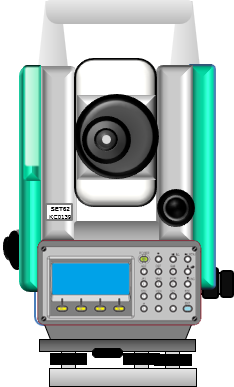G. Theodolite and Total Station
1. Instruments
Transits, theodolites, and total stations are an evolutionary family. Although newer instrument types replaced older, their uses often overlapped as adoption took place. Because their measurement functions are fundamentally the same, they are subject to similar instrumental errors and compensation methods. The more sophisticated later instruments have fewer user-accessible adjustments by design and use electronics to digitally compensate some maladjustments.
a. Transit
A traditional transit, Figure G-1, is an open design instrument with four leveling screws. Its adjusting screws are easily accessible and most of its moving parts, including the angle reading system, are exposed. This open exposure leads to faster wear and more frequent maladjsutment.
 |
| Figure G-1 Transit |
Transits are obsolete, used primarily for shelf display so they are not covered in this chapter. Most of their checks and adjustments parallel a theodolite's but if demands warrant, I can create a separate chapter for transits.
b. Theodolite
A theodolite, Figure G-2, is an enclosed design with an optical reading system and three leveling screws. Most adjusting screws are are under covers or otherwise protected and its moving parts are better sealed than a transit's. When carefully used, a theodolite is less susceptible to maladjustment than a transit.
 |
| Figure G-2 Theodolite |
Theodolites were produced for a broad spectrum of needs, from construction to high accuracy control surveys, resulting in models with different capabilities and controls. Some had a separate bubble for manual vertical circle orientation, others an automatic gravity-actuated circle. A repeating theodolite used an upper and lower horizontal circle lock and slow-motion, a directional theodolite only a single lock/slow-motion assembly. Early theodolites were analog instruments with an optical angle reading system; later instruments were digital.
Except for vertical circle orientation, primary theodolite checks and adjustments are similar across different models. Those unique to a particular instrument are explained in the instrument's manual.
c. Total Station
A total station instrument (TSI), Figure G-3, shares mechanical characteristics, including enclosed design and three leveling screws, with a theodolite. A TSI uses a digital angle reading systems and incorporates an electronic distance measurement (EDM) capability. Most TSIs also have the ability to self-correct some instrument maladjustment conditions.
 |
| Figure G-3 Total Station |
Many theodolite maladjustment are the same for TSIs. Digital and electronic systems, particularly those with no TSI equivalent, require specific checks. These are detailed in an instrument's manual. Because they have similar parts and controls, theodolite and TSI checks are combined; those specific to one or the other are called out.
A modern TSI compensation system measures axes tilts and corrects angle measurements accordingly. A particular TSI may use a single axis system which corrects only zenith/vertical angles for axis tilt or a dual-axis system which also corrects horizontal angles errors caused by axes tilt.
That's not to say a TSI's compensation system is infallible. As with any other adjustment aspect of the TSI, the compensation system shouldn't presumed to be without error. While an automatic level's compensator is relatively easy and quick to check, those of a TSI are more complex. The instrument's manual will have information on its compensation system, its sensitivity, and how to check that it is working correctly. Not all TSIs use the same compensation design, even from the same manufacturer, so procedures in the manual should be followed.